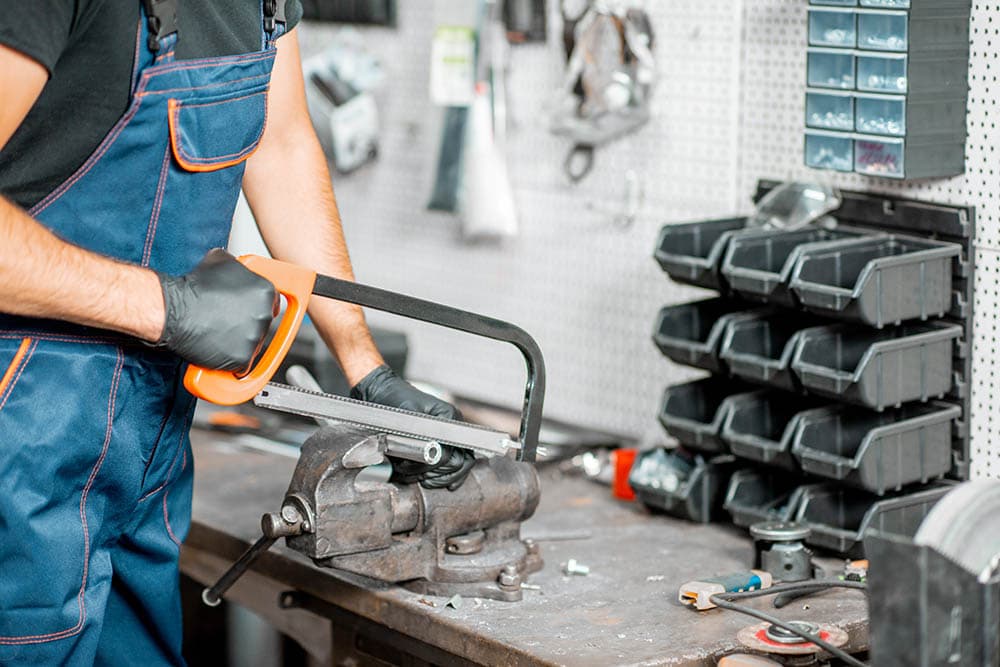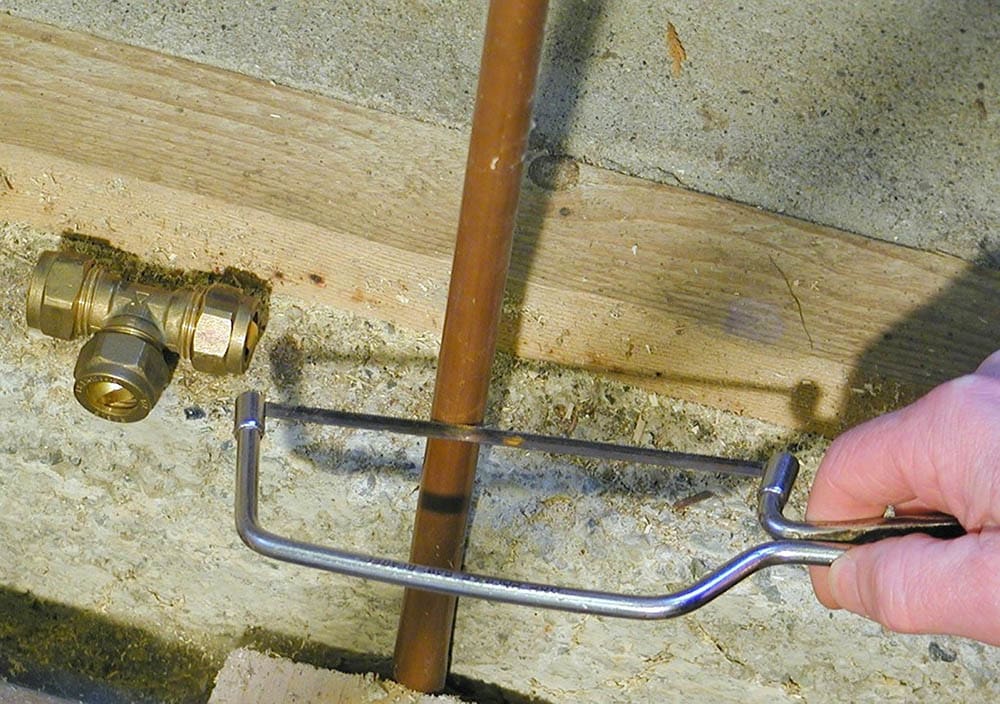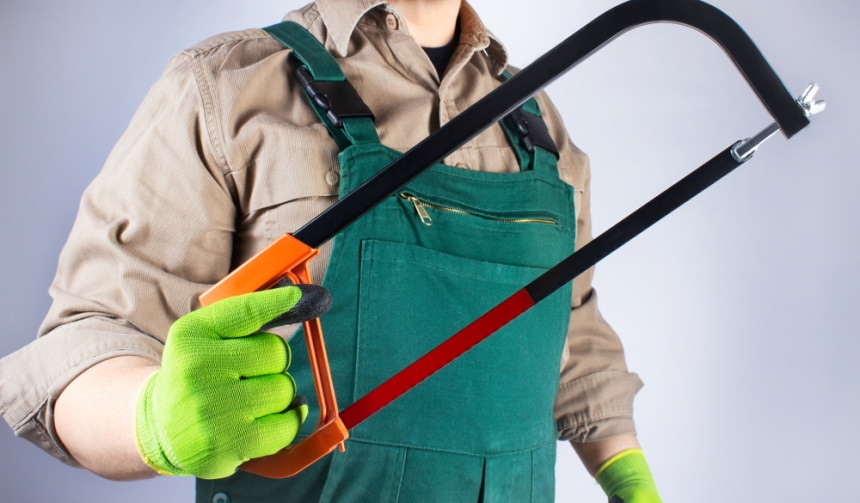Coping Saw vs. Hacksaw: Pros, Cons, Differences & Uses
-
Shea Cummings
- Last updated:

Coping saw versus hacksaw—how do you know which is best for your project? With so many tools available that can do similar jobs, sometimes it’s hard to decide which one to use. If you happen to be a tool collector, you might as well get both for when the situation for either arises.
If you want to know which works best for certain projects, keep reading as we discuss each saw briefly and give you some tips on when to use each. We’ll also review a few other things you may want to consider when getting a new coping saw or hacksaw.
Overview of a Coping Saw
A coping saw consists of a handle, frame, and an extremely thin, fine-toothed blade. Some designs seem bulky, but a coping saw is a lightweight handsaw designed for intricate cuts in softer materials like wood, plastic, or thin pieces of metal.
You can get different blades for a coping saw, but none of them are designed for any kind of heavy-duty cutting. And because of how thin and flexible the blades are, you can bend them to cut into different shapes or angles based on what you’re trying to cut.
In addition to a manual coping saw, you can even get battery-powered or electric coping saws that are more powerful. These versions still have tiny blades for precision cutting, but they take most of the manual work out of cutting. Plus, many of them offer a variable speed design for the ideal cut.
When to Use a Coping Saw
Coping saws are quite popular in cabinetry or furniture-making because they offer the precision to make fine cuts with minimal material and no damage to the surrounding area. Even hobbies like woodworking, where you’re building birdhouses or other small projects, will often benefit from a coping saw.
You can even get blades capable of cutting tiles with a coping saw. These wouldn’t be ideal for doing the majority of the cutting. But if you run into a spot where you need to make an odd-shaped cut to fit a tile, a coping saw may be the ideal tool.
- Battery-powered and electric versions are available
- Multiple blade types for different cuts
- Ideal for precision cutting
- A great addition to the woodworker’s tool kit
- Not much room for error with such a small blade
Overview of a Hacksaw

Similar to the coping saw, a hacksaw is also made up of a handle, blade, and frame. However, you’ll notice a significant difference right away when looking at the two side by side. A hacksaw is typically equipped with a much heavier-duty handle and frame. And while the blade is still thin compared to a regular handsaw, it’s noticeably thicker than a coping saw.
Another similarity between the saws is that you can get multiple types of blades. Still, the most commonly used are fine-toothed blades designed for metal. There are also electric and battery-powered options available. But suppose someone is going the powered route. In that case, they will often go with a reciprocating saw with bigger but similar blades to a hacksaw.
When to Use a Hacksaw
Typically a hacksaw is best used in various construction applications. For example, many electricians use a hacksaw to cut through cables or cable trays. Or concrete workers may use them for quick cuts in the rebar if they don’t have big chop saws available.
Because they typically have more aggressive teeth and are less flexible, a hacksaw is not ideal when precision is necessary. They can easily scratch materials like tile or metal. So, it’s important to stay in control of the cut.
- Heavier for cutting larger materials
- Easily cuts through metal rods or pipes
- Multiple blade options are available
- Not ideal for precise cuts
- Not usually a first choice for cutting wood
 Difference Between the Saws
Difference Between the Saws
The primary difference between a hacksaw and a coping saw is what they are designed to cut. At a glance, you can tell the difference between the two by the blades. And when you pick them up, the coping saw will almost always be noticeably lighter as well.
Between each saw, you can also change blades. For example, you can get hacksaw blades designed to cut only metal, or you could get what’s called a bi-metal blade, which is more of an all-purpose blade. The same goes for a coping saw. Whether you’re primarily cutting wood or metal will determine the type of blade you get for the saw.

Safety Considerations
Like any tool, there are always safety concerns. Whether you’re using a coping saw or hacksaw, safety measures for each are similar. Being saws, the primary concern is with cuts. Ideally, you should be wearing some cut-resistant gloves to avoid injury. If you’re using a powered version of either saw, you may also need hearing and eye protection.
Manual vs. Powered
There are powered versions of both of these tools. A manual version is often preferred when it comes to a coping saw because it typically allows a lot more precision. Because a hacksaw is used to cut bigger material, it’s sometimes nice to go with a battery-powered or electric version to save on manual labor.

Ideal Uses for Each Saw
- Furniture building
- Wooden toy building
- Fine woodworking projects
- Tile setting
- Finishing projects
- Cutting metal rods or pipes
- Cutting electrical cable
- Cutting rebar
- Various construction tasks
 Conclusion
Conclusion
Neither of these saws is a significant expense, especially if you go with a manual one. If you’re a professional, you likely know which one you need. But as a DIYer, both saws make an excellent addition to your tool bag. There are many applications around the house for these two tools if you like to take care of things yourself instead of hiring contractors.
- See also: 7 types of hacksaw frames and blades
Featured Image Credit: (L) Wandering Jones, Shutterstock | (R) antoniodiaz, Shutterstock
Contents


